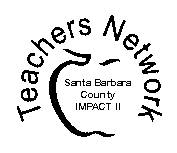The TeachNet Project sponsored with major funding by the AT&T Learning Network,
seeks to improve student achievement by providing training, grants, networking and resource sharing to teachers at four of the Teachers Network affiliates nationwide.


www.qad.com
OaksN'KidsUnit
How it works:
Students
investigate the local oak community, use a variety of technological tools and
develop an awareness of local environmental issues without leaving their school
grounds. The study area, the school perimeter, is easily accessible and
contains other interesting study specimens such as native plants and
animals. In the computer lab students complete exercises, conduct oak
research on the Internet, input data, create tables/graphs and complete
PowerPoint activities. During field study, students use hand lenses,
microscopes, a video microscope., field guides, field keys, field collections
and insect collection materials.
Assessment:
Pre-assessment Activity
The class discusses oak habitat,
oak communities and oak environmental issues.
The teacher asks questions to identify student's prior knowledge.
Monitoring
Student Progress
Class discussions that analyze
information is ongoing. Students
complete an Excel table each day of field study and print out computer exercises
on computer work days to demonstrate progress on projects.
Final
Assessment
(How will you know that they learned it?)
Computer Literacy Exercises -
Each individual student has completed various exercises to determine
understanding of the basic tools of Excel, Microsoft Word and PowerPoint before
the project begins. Students spend
several days researching oak information on the Internet add more oak facts to
their final project.
Individual PowerPoint Presentation - Each individual student will complete a PowerPoint presentation with an introduction, map, table, graph and conclusion page. This project will be graded using the oak project rubric and then added to a science portfolio for parent evaluation
Standards:
Science
Language Arts: Writing Strategies
Technology: Technology Tools and Resources and Research
Software or Materials Used: Microsoft Office, Paint
Keywords: Oaks, oak communities, life science
The
Students:
Participants consist of 7th
graders including English Learners, GATE, special and regular education
students.
Overall Value:
Integrating standards is a natural component of the Oak Communities Project because it addresses the scientific investigation and experimentation portion of science standards. Students communicate logical connections between a hypothesis, scientific concepts, and data collected. Language arts standards are communicated through scientific tips and results leading to conclusions drawn from scientific evidence. The final PowerPoint presentation demonstrates a grasp of technology standards. An oak project rubric is used to grade projects and exercises.
Details:
Subject Area: Science
Second Subject Area (if interdisciplinary): Language Arts
Starting Grade Level: 7th Grade
Tips for the Teacher: This project is adaptable to any grade level and school environment, substituting any natural feature for oaks. Ordinary materials such as string, rulers, cardboard and washers can be used to construct measuring deices. Assignments can be adapted to fit a school's technology capabilities by creating a class data survey or group PowerPoint presentation.

Suzanne Squires
Suzanne has taught seventh and eighth grade science, physical education, computer applications, agriculture and art since 1996. She has Level 2 CTAP and CLAD certification and coaches boys and girls volleyball at Los Olivos School. Serving as a facilitator for the UCSB projects Science Partnership for School Innovation and Beyond The Classroom for six years helped her develop several key units using standards and t3echnololgy. She is a Distinguished Educator for the County of Santa Barbara for 2003 and 2004.